La Basse Cour: B&B near Alencon, Normandy
Gardens, Chateaux & Sights
in Normandy and Pays de Loire
Alençon
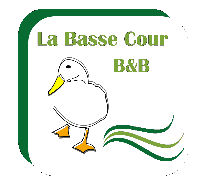
Alençon old town is a maze of narrow medieval cobbled streets, with dozens of cafes, shops, restaurants, parks and street markets (Thursday and Saturday). The Parc des Promenades near the château regularly hosts open-air shows, festivals and fairs and has a delightful rose garden near the bandstand.
You can hire a handset and follow an audio tour on foot from the Alençon Tourist Office. This is housed in the former palace of the Dukes of Alençon, the 'Maison d'Ozé', next to the spectacular Basilica of Notre Dame. Nearby in Rue St Blaise you can visit the family home of St Therese of Lisieux, which draws pilgrims from around the world, and the exhibition of Alençon lace in the Museum of Fine Arts - the lace workshops are just next door.
You will find many excellent restaurants, cafés and bars in Alençon.
From November 2019 the grounds of the Chateau des Ducs, Alencon's medieval castle, is newly landscaped and opened to the public. It now links the main car park (free) next to the Town Hall with a pretty park on the other side of the little river Briante.
Day Trips in Normandy and Pays de la Loire
- Sées cathedral, Haras du Pin and secret Châteaux of the Orne
- Falaise, Vendeuvre and Camembert in the Pays d'Auge
- Historic Town and Cathedral of Chartres
- The Alpes Mancelles to the west of Ancinnes
- Fresnay-sur-Sarthe, Sillé-le-Guillaume, Jublains, Ste Suzanne
- Le Mont Saint Michel, Domfront, Bagnoles de l'Orne
- D-Day Normandy Landing Beaches and Museums
- Heritage and Antiques Trail in the Perche Park
- The Perseigne Forest, Belvedere and Villages
Châteaux, Gardens etc. in Normandy and Pays de la Loire
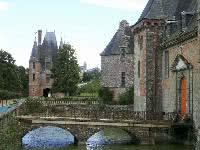
- Ballon - Fortress and gardens
- Camembert - Home of the most famous cheese in France
- Carrouges - Château de Carrouges
- Domfront - Château and old town
- Lassay les Châteaux - Châteaux de Lassay, Mayenne
- Le Pin au Haras - Haras du Pin national stud farm
- Mortrée - Châteaux d'Ô et de Médavy
- St Céneri-le-Gérei - village and Mansonière Gardens
- St Christophe-le-Jajolet - Château de Sassy
- Saint Rémy du Val - Logis du Moullins
- Saulges - Caves and grottoes
- Sées - Cathedral and Religious Art Museum
- Vendeuvre - Château and water gardens, museum of miniature furniture
- Ancinnes - Couesme Manor House
Gardens to Visit in Normandy and Pays de la Loire
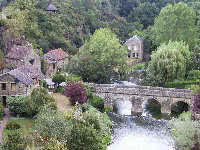
The number of gardens to visit in Normandy and Pays de Loire is enormous so we have listed a selection on a special page
Gardens in Normandy and Pays de Loire.
Château de Sassy
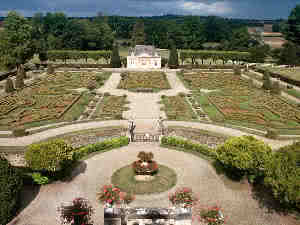
A traditional formal French garden with pathways leading from the château and its terraces, inviting the visitor to walk the length of the gardens. At one end of the garden is a charming orangery, framed by limes.
The hedges which border the garden and individual beds are constructed of evergreens such as boxwood, yew and bay.
The whole of this site was constructed over the course of more than century: from the main part of the château at the end of 18th to the creation of the French garden about 1925.
Opening : From the 15/6 to the 15/9, 10h30 to 12h30 and 14h to 18h. Easter Saturday to the 14/6 and the 16/9 to the 30/9, weekends and festivals, 15h to 18h.
Self-guided visits to the garden, guided for the château.
Château d'O
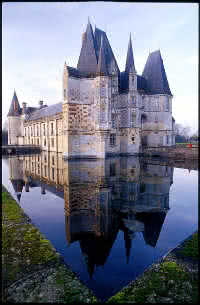
It matches in beauty the best châteaux of the Loire.
The decoration of the interior court, the complexity of the roofs, the slim character of the turrets, the marriage of brick and stone, all add to the elegance and charm of the château. Inside are pretty frescoes and trompes l'oeil.
The château is open most afternoons from June to mid-September from 1.30pm to 5.00pm.
Close by is the Château de Médavy. Haut page
Château de Médavy

The château houses some interesting 19th century furniture and the library has some wonderful original maps of the departements of France as they were at the time of their creation following the Revolution.
Close by is the Château d'O. Haut page
Château de Carrouges
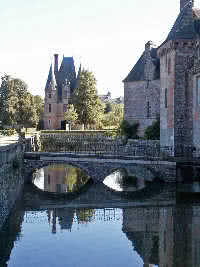
Growing in size and grandeur between the XIV (the fortified keep) and the XVII (two renaissance aparment wings) centuries, the Château de Carrouges evolved with Normandy itself and was embroiled in both the Hundred Years War and the Wars of Religion. Broad moats fortify the buildings. The château was originally owned by the Carrouges family then passed through marriage to the Blosset and Le Veneur families, where it stayed until 1936 when the castle became property of the State, the owners' iron forging business having fallen into hard times during the 19th century industrial revolution and the upkeep becoming unaffordable.
The entrance is via the brick red gatehouse and steep roofs, behind which you will discover the castle. Cross the bridge over the moats and enter the castle to arrive at the beautiful interior courtyard, before entering the main buildings to explore the rooms and apartments.
There is a shop housed in the nearby "Collegiale" church with a good selection of locally produced produce and crafts, as well as a small gift shop in the château courtyard.
Self-guided visits to the garden, guided (45mins) for the château.
Open all year except Christmas Day.
April 1 - June 15 and Sept 1 - 30: 10.00 - 12.00 and 14.00 - 18.00
16 June - 31 August: 09.30 - 12.00 and 14.00 - 18.30
1 Oct - 31 March 10.00 - 12.00 and 14.00 - 17.00
Website for Château de Carrouges Haut page
Domfront
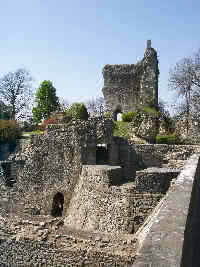
Today the ruins of the keep and a dozen towers remain, hinting at the power of the medieval city coveted by lords and kings, both English and French. The court of Henri II was once housed here.
The old town is well preserved; you can see the half-timbered houses, cobbled streets, architectural details, sculptures and roofs which attest to its long history.
Do not miss pans from the north ramparts onto the valley, and from the garden of the keep towards Mont Margentin. Haut page
Ballon
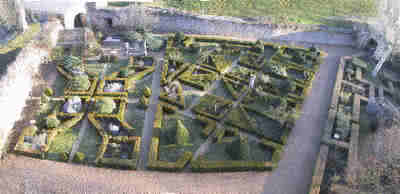
It has been classed as a national monument for almost a hundred years (1923).
It is surrounded by extensive medieval and renaissance gardens which display topiary, fruit trees, old-fashioned roses, clematis, paeonies and viburnums.
Opening hours
- May to mid July, gardens open every weekend from 14h30 to 18h30
- mid July to end of August, gardens and castle keep open every afternoon 14h30 to 18h30, except Thursday Haut page
Haras du Pin
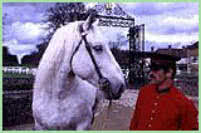
The buildings, brought into service in 1730, were built according to plans of Pierre Le Mousseux and the parks were inspired by Le Nôtre.
Called the Versailles of the horse, the Haras du Pin is home to sixty stallions of 10 different races.
If you love horses, do not miss the Thursday demonstrations of carriage driving and horsemanship in the grounds (June to September) in the Cour Colbert.
It is possible to visit in addition the stables, the saddle rooms and the paddocks, plus the château, its furniture, its pictures and the XVIIc tapestries. Haut page
Sées
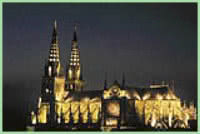
The cathedral, a splendid and majestic monument of the XIII and XIV centuries, underlines the religious character of the city which accomodates a number of religious communities, seminaries and colleges.
Built on an unstable ground, it had to be reinforced by enormous buttresses on each side: in XVI century, the front façade began to lean dangerously and further support was needed; despite these additions, the building remains one of the most beautiful examples of Norman Gothic art.
The 70 m high spires can be seen from more than 10 kilometres away. Outside, see the central and side portals. Inside, the choir, the transept and the high altar from the Louis XVI period, designed by Brousseau. The organ is a 1743 Parisot, later turned into a Cavaillé-Coll in 1883 and restored in 1972.
Some of the other churches and sites in the city deserve to be visited - for example the Basilique de l'Immaculée Conception. The cathedral and town were used as the backdrop for the film "Jeanne d'Arc", the award-winning 1999 masterpiece of writer and director Luc Besson, starring Milla Jovovich as Joan of Arc, Dustin Hoffman as The Conscience, Faye Dunaway as Yolande D'Aragon and John Malkovich as The Dauphin / Charles VII.
In summer the "Musilumières", a fabulous light and music show inside the Cathedral, starts at 10.30pm and is well worth a visit after an evening meal in one of the nearby restaurants. Haut page
Camembert
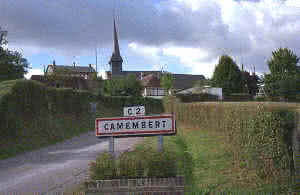
Although all of Normandy produces cheese, the Pays d'Auge and Pays de Bray are most well known thanks to the fame of certain cheeses: Camembert, Livarot, Pont-l'évêque and Neufchatel. Most famous of all is Camembert, a national symbol along with the baguette and the beret.
From the Middle Ages, you find traces of commercial cheese production in Camembert.
The Camembert we know today was actually created in the XVII century, although legend gives credit to Marie Harel, supposedly given the secret of the recipe by a monk to safeguard it at the time of the Revolution. The invention of the now traditional poplar wood Camembert box was essential to the success of Camembert from the 1890s, as it made it easier to transport.
Visit the Camembert museum at the tourist office where the complex, 10-stage process of making this cheese is explained. They can also give a list of places selling cheese direct from the farm and where to lunch.
While you are here, you should also try to visit one of the many farms that produce calvados and pommeau. One such is owned by Monsieur Ollivier at the nearby village ofCrouttes, who always gives a warm welcome to visitors on his lovely 17th century farm, but you will see signs for calvados, pommeau and poiré by the side of many a road.
Château de Vendeuvre
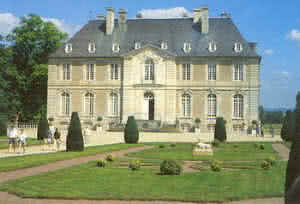
St Céneri-le-Gérei and the Gardens of La Mansonière

There are several restaurants and creperies here to choose from for lunch - make sure you do not leave it too late as they get busy in season. Make sure you visit the church from where there are wonderful views down the valley and some very interesting sculptures and frescoes inside, particularly the unusual metal sculptures of the stations of the cross. The walk along the riverside, which is lit up at night, leads to the old chapel of St Céneri, where on the opposite river bank is a stone shrine marking the spot where the miraculous spring came forth at the saint's behest.
Nearby (on the road north) the Jardins de la Mansonière is a delightful garden that must be visited, open every afternoon except Tuesday June to early September, and open Friday-Sunday afternoons in May. There are nine gardens to explore, each to a different theme and design.
Last Saturday of each month June - August the gardens host musical evenings in the open air (under cover if weather is inclement) and the paths through the gardens are lit at night by candles, making a delightful spectacle. Haut page
Lassay les Châteaux
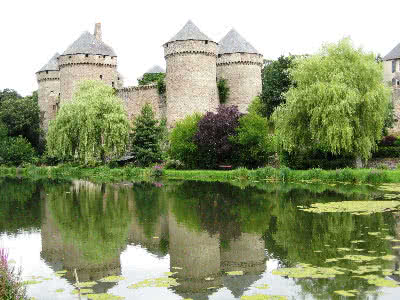
Before visiting the château, cross the roadbridge (downhill from the crossroads in the town centre) and go down the steps to the lake for a view of the château from below; circle the lake and climb up the track to the château itself. The guided visit includes the exterior and interior of the château, the ramparts, the various defensive structures, and the surprisingly attractive grounds and gardens.
The second château, château du Bois-Thibault, is also worth a visit if time allows - you can safely miss the château du Bois-Frou.
Open weekend afternoons from Easter to end of May 14h30 to 18h30
Open every afternoon June to end of September 14h30 to 18h30 Haut page
Logis du Moullins
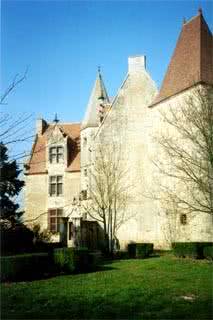
The House of Rural Life (Maison de la Ruralité) at St Rémy-du-Val houses an interesting exhibition (weekends only except by appointment) showing how hemp used to be grown, processed and used in the region; after a long period of decline, hemp is once again being grown in northern Sarthe and is used for house insulation. In the same village are the remains of a hilltop motte-and-bailey fortification and a traditional hemp oven, both near the church.
Couesme Manor House

The lords of Couesme first settled in the area around the year 1000 remained until 1669, the date when the Manoir de Couesmes was sold to the de Louvigny family. Charles de Couesme built up an immense fortune through marriage to successive sisters of the Harcourt family, barons of Bonnétable.
In the 17th century the manor fell into a state of abandon but was restored by the lords of Louvigny who demolished those parts of the property which were considered beyond repair.
At the time of the Revolution, Couesme manor and its outbuildings were being used for agricultural purposes and continued as farm buildings under successive owners. No interior changes were made until 1960-1970 when part of the ground floor was made habitable.
The house was added to the register of historic monuments (ISMH) in December 2005. Full restoration of the manor will take several years due to the scale of the work required.
Apart from occasional visits organised by the local tourist offices, special exhibitions and European Heritage Days (JEP), individual and group visits can be arranged with the owners on request. The exterior is open to the public daily.
Tel : 06.87.73.26.15 ou 02.33.26.49.44 Haut page
